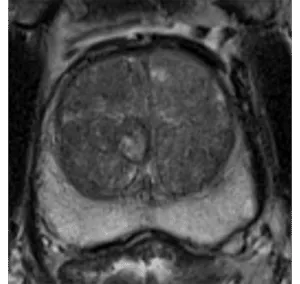Prostate Volume Calculator + PSA Density Calculator
References:
- Stanzione A, Ponsiglione A, Di Fiore GA, et al. Prostate Volume Estimation on MRI: Accuracy and Effects of Ellipsoid and Bullet-Shaped Measurements on PSA Density. Acad Radiol. 2021;28(8):e219-e226. doi:10.1016/j.acra.2020.05.014
- Haas M, Günzel K, Miller K, Hamm B, Cash H, Asbach P. Is the Ellipsoid Formula the New Standard for 3-Tesla MRI Prostate Volume Calculation without Endorectal Coil?. Urol Int. 2017;98(1):49-53. doi:10.1159/000448593
- Littrup PJ, Williams CR, Egglin TK, Kane RA. Determination of prostate volume with transrectal US for cancer screening. Part II. Accuracy of in vitro and in vivo techniques. Radiology. 1991;179(1):49-53. doi:10.1148/radiology.179.1.2006303
Related Calculators:

More about the prostate volume & PSA density calculator:
Prostate volume and PSA density are critical metrics in the early detection, diagnosis, and management of prostate conditions, including prostate cancer. Our calculators are designed to provide fast, precise, and user-friendly estimations using advanced imaging data. By offering accurate prostate volume and PSA density measurements, these tools empower healthcare professionals to make informed decisions and improve patient outcomes.
The calculators integrate state-of-the-art algorithms and evidence-based formulas, ensuring reliability in clinical settings. By simplifying complex calculations, they help clinicians focus on patient care while maintaining diagnostic accuracy. These tools are particularly valuable for guiding decisions in biopsy recommendations, risk stratification, and treatment planning for prostate cancer and benign prostatic hyperplasia (BPH).
The Role of PSA in Prostate Health
Prostate-specific antigen (PSA) is a protein produced by the prostate gland and is widely used as a biomarker for prostate health. While PSA is naturally present in the blood, elevated levels can indicate various prostate conditions, including inflammation, BPH, and prostate cancer. However, PSA alone has limitations in distinguishing between benign and malignant processes, leading to potential overdiagnosis and unnecessary biopsies.
To improve the specificity of PSA testing, additional parameters such as PSA velocity (rate of PSA increase over time), PSA doubling time, and PSA density (PSAd) are used. These refinements enhance the ability to differentiate between clinically significant prostate cancer and indolent cases, reducing unnecessary interventions while ensuring timely detection of aggressive disease.
PSA Density: Enhancing Diagnostic Accuracy
PSA density (PSAd) is calculated by dividing the serum PSA level by the prostate volume. This metric accounts for the fact that larger prostates, particularly in cases of BPH, may naturally produce more PSA, leading to higher PSA levels that do not necessarily indicate cancer. By normalizing PSA levels based on prostate size, PSA density helps clinicians refine risk assessment and prioritize patients for further evaluation.
Studies have shown that PSA density provides better specificity in detecting clinically significant prostate cancer (csPCa) compared to PSA alone. A PSAd threshold of 0.15 ng/mL/cm³ is commonly used to differentiate between benign conditions and potential malignancy, though this cutoff may vary based on patient demographics and imaging findings.
Prostate Volume and Its Clinical Significance
Accurate prostate volume estimation is crucial for interpreting PSA levels and planning treatment strategies. Prostate volume is typically measured through imaging techniques such as transrectal ultrasound (TRUS) and multiparametric MRI (mpMRI), with common calculation methods including the ellipsoid and bullet-shaped formulas.
Prostate volume plays a key role in:
- PSA Interpretation: Larger prostates naturally produce more PSA, making volume measurement essential for contextualizing PSA levels and improving diagnostic accuracy.
- BPH Management: Prostate size influences treatment choices for benign prostatic hyperplasia, including medical therapy, minimally invasive procedures, and surgical interventions.
- Prostate Cancer Risk Stratification: An enlarged prostate with a normal PSA density is less concerning than an average-sized prostate with an elevated PSA density, guiding biopsy decisions.
- Radiation and Surgical Planning: Treatment modalities such as brachytherapy and radical prostatectomy require precise volume assessment for optimal dosing and procedural accuracy.
Advanced Imaging and Prostate Volume Calculation
Multiparametric MRI (mpMRI) has significantly improved prostate cancer detection and staging. High-resolution imaging, particularly with 3-Tesla MRI, allows for more precise prostate volume measurements and lesion characterization. The integration of MRI-based volume assessments with PSA density calculations has been instrumental in reducing unnecessary biopsies and identifying aggressive cancers that require immediate intervention.
Comparing Prostate Volume Estimation Methods
Several techniques are used to estimate prostate volume, each with varying degrees of accuracy:
1. Ellipsoid Formula
The ellipsoid formula, which approximates the prostate as an ellipsoid (width × height × length × 0.52), is widely used in clinical practice. It provides a practical balance between simplicity and accuracy, making it an effective tool for routine prostate volume assessment.
2. Bullet-Shaped Formula
The bullet-shaped formula modifies volume estimation by accounting for asymmetries in prostate shape. While it may offer improved accuracy in certain cases, its clinical adoption remains limited due to variations in results compared to standard methods.
3. Planimetric and Manual Segmentation Techniques
More precise methods, such as manual segmentation using MRI slices, provide highly accurate volume measurements. However, they are time-intensive and require specialized software, making them less practical for routine clinical use.
PSA Density in Clinical Decision-Making
PSA density has become an essential tool in refining prostate cancer screening strategies. It is particularly useful in men with PSA levels in the "gray zone" (4-10 ng/mL), where distinguishing between benign and malignant conditions is challenging. By incorporating PSA density into risk models, clinicians can more effectively identify patients who would benefit from targeted imaging or biopsy.
Integration with Contemporary Diagnostic Pathways
With advances in prostate cancer diagnostics, PSA density is now frequently used alongside other risk stratification tools, such as:
- Multiparametric MRI: Aids in lesion characterization and targeted biopsies.
- PI-RADS Scoring System: Helps categorize prostate lesions based on imaging features.
- Genomic and Biomarker Tests: Provides additional molecular insights into prostate cancer aggressiveness.
Conclusion
Prostate volume and PSA density are invaluable parameters in the assessment and management of prostate conditions. By integrating these metrics into clinical workflows, healthcare professionals can improve diagnostic precision, reduce unnecessary interventions, and enhance patient outcomes. Our prostate volume and PSA density calculators provide a streamlined, evidence-based approach to these critical calculations, supporting informed decision-making in prostate health management.
For more detailed information on the methodologies and clinical evidence supporting these calculators, please refer to the references listed above.
Ellipsoid Prostate Volume=π/6×DAP×DL×DT
Bullet shaped Prostate Volume=π/4.8×DAP×DL×DT
DAP= Maximum diameter in the Anterior-Posterior plane
DL= Maximum diameter in the Longitudinal plane
DT= Maximum diameter in the Transverse plane





Thank you for this very helpful site.
Saves a lot of my reading time and improved my accuracy
please check Prostate volume calculator. The calculation tool is incorrect.
Thank you for your kind feedback Dr. Doss. The issue has been resolved.